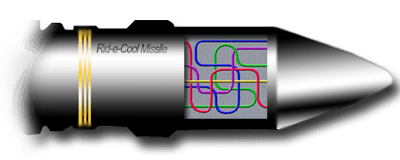Night Vision
Night vision aids your vision in poor light or even in total darkness, hence making you a super human being. Your opponents minor weakness becomes your greatest strength.
Night vision devices (NVDs) are used by spy agents, security, military personals, hunters and adventure enthusiasts.
These devices mostly use two technologies namely active night vision and passive night vision.
Active Night Vision
Active night vision is categorized as generation 0 of the NVDs. It was initially used by the US army in Second World War. Active night vision devices throw infrared light and are similar to a TV remote control. In this technology an infrared beam is thrown on the surroundings, when these infrared beams strike an object they are reflected back and create an image.
Active night vision technology is mostly used in consumer devices like cameras. It was stopped being used for military purpose when the US rivals quickly duplicated these devices, this gave them the ability to detect the infrared rays emitted by the devices
Passive Night Vision
This technology offers the next generation, i.e. generation 1, of NVDs. It uses passive infrared. It was initially called by US army as Starlight. This technology enabled the night vision devices to avoid throwing infrared beams; hence it could not be intercepted easily.
These devices have the ability to intensify the dimmest light from stars and moon. For this purpose an image intensifier is used. Light is composed of extremely small particles called photons.
The basic principle behind this technology is the photoelectric effect of a photon, when a photon hits a surface it ejects electrons from the surface. These emitted electrons are then intensified thus successfully creating an image. Passive night vision can even work in very poor light as well.
Theoretically speaking light from the dimmest visible star is sufficient to create a clear image. Mostly the image generated by this technology is green in color, because human eye can distinguish shades better in green than in any other color. This technology is mostly used in war reporting.
Generation 2, 3 and 4 category devices use the same basic principles, but are improved versions of their predecessors, offering very good resolution and much less noise. Some modern devices use both technologies (active and passive) simultaneously to produce a crisp image.
Thermal imaging
Another important night vision technology is thermal imaging. This technology helps to view not only in poor light but also aid during daytime. This technique uses sensors to detect the heat emitted by an animal or some other warm object.
It is interesting to note that nature also use this methodology e.g. boas, pit vipers etc. Some experts dont consider this technique as actual night vision because it detects heat rather that providing a clear image of the surroundings.
Thermal imaging also helps in detecting recent changes in a specific area. For example thermal sensors can detect if a ground has been dug recently. This technology can also be used detect fresh footprints. Hence this technique is extremely useful for hunting clues hence pretty much useful for investigators and other secret agents.
Another important use of this technology is in vehicles. Some vehicles have thermal sensors, which enable them to view objects that are out of the range of headlights. In this case an image is displayed on a screen in the vehicle. Hence telling in advance what lies ahead and if a living thing is in the way it is shown on the screen.
Devices
Night vision technology has its variety of applications not only for military purposes but for home use as well.
Goggles
Night vision goggles are most popular devices using the night vision technology. These devices consist of two eye pieces having lenses. Some of these goggles come with a built in infrared illuminator which assists in viewing the surroundings in poor light. The range and quality of the IR illuminator determines its price. Night vision goggles offer two styles hands-free and hand-held. Hands-free interface is good for multitasking purposes and is mostly used by commandos, paratroopers and helicopter pilots.
Cameras
Some modern cameras utilize the night vision technology. These cameras are installed in dark rooms and dark corners of a building. These cameras are also used in helicopters to aid viewing under low light conditions. Some of the modern camcorders have built in night vision capability.
Scopes
Some of the scopes also use the night vision technology. These scopes are mostly mounted over a weapon, e.g. a sniper rifle, or can also be held in hand. Such scopes, when mounted on a gun, enable aiming accurately in low light.
Micro Nightspyer
See in the Dark up to 25 Feet
Overview: The Micro Nightspyer lets you illuminate the night on your secret spy mission. Press a small button and a red tinted focused light beam allows you to see your target in the dark. The 2x power telescopic lens permits visibility up to 25 feet.
CAUTION: Viewing the sun can cause permanent eye damage. Do not view the sun with this product or even the naked eye.
Go from Night Vision to Homepage











New! Comments
Savvy spies can comment here... Just leave me a comment in the box below.